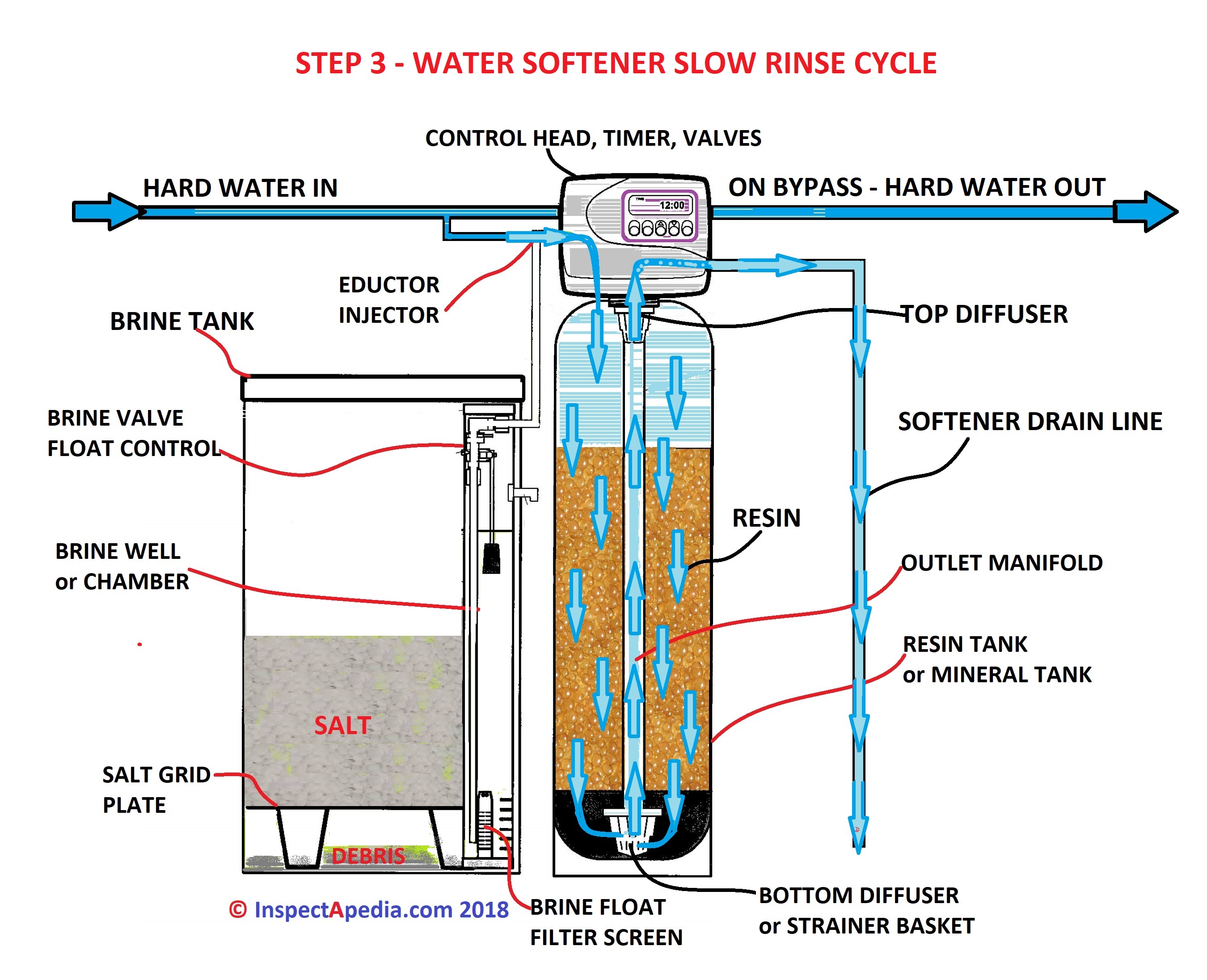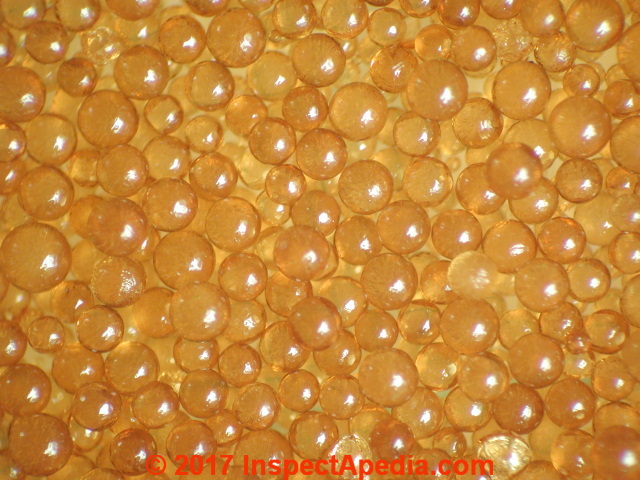 How Water Water Softeners Work
How Water Water Softeners Work
Water Softener Operation: Service Cycle & Regen Cycle Steps
- POST a QUESTION or COMMENT about types of water softeners, what controls are found on water softeners, & how water conditioners and water softeners actually work.
Water softener operation: here we explain how water softeners and similar water conditioners work, types of water softeners, and the basics of what water softener controls are present and what they do.
How water softeners work, methods to remove minerals from home water supply.
Our page top sketch identifies the basic parts of a water softener.
InspectAPedia tolerates no conflicts of interest. We have no relationship with advertisers, products, or services discussed at this website.
- Daniel Friedman, Publisher/Editor/Author - See WHO ARE WE?
How Water Softeners Actually Work - Water Conditioners Operation & Ion Exchange Water Softeners
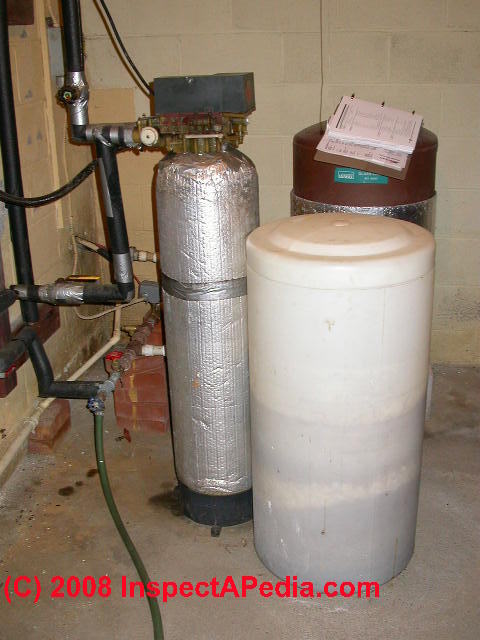 Conventional ion-exchange water softeners
Conventional ion-exchange water softeners
used to remove minerals from "hard" water in buildings usually use salt in an ion-exchange process, swapping in sodium ions (salt) and causing calcium and magnesium to precipitate out of the building water supply (and to collect in the water softener).
[Click to enlarge any image or table]
Incoming "hard" water flows (tan arrow in the photo) through the resin tank where it is treated or softened, and soft water (blue arrow in the photos) flows out of the resin tank into the building's water supply.
Definition of "hard water":
Hard water is generally taken to mean water containing minerals over 121 mc (micrograms) per liter of water, or over 7 grains of hardness per gallon.
Hard water contains high levels of positively-charged ions or "Cations" of calcium, magnesium, and possibly other minerals. These are the minerals that form white or gray scale in pipes, as a ring around your bath tub, and on dishes and pots if your water supply is "hard" or high in these minerals.
Salt in the brine tank
(red arrow in our photo) is used to place a charge of salt molecules in the resin tank (green arrow). During a regen cycle (explained below) under control of a timer or on some systems more advanced systems that actually monitor the mineral level in the water supply.
Resin inside the water softener
treatment tank (green arrow in our photo) contains salt molecules which are brought into contact with building water as it passes through the softener.
The "resin" is made of tiny plastic beads of zeolite which are coated with salt or potassium ions. (Ions are molecules that have an electrical charge.)
What is the Water Softener's "In-Use" or Normal Service Cycle?
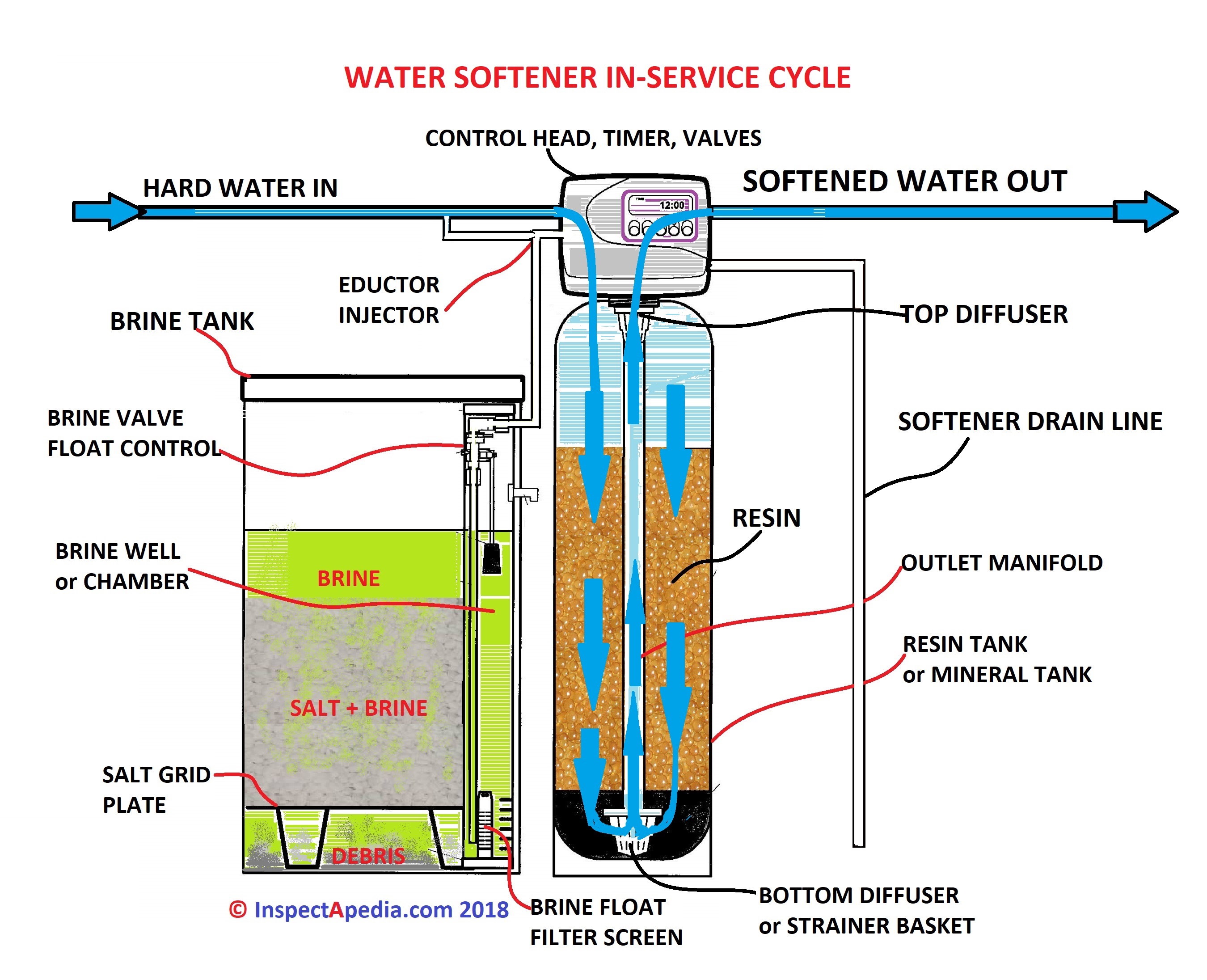 In our sketch we show the pathway of the building water supply when the water softener is in service, delivering softened water to the building:
In our sketch we show the pathway of the building water supply when the water softener is in service, delivering softened water to the building:
incoming "hard" water flows through the resin tank where it is treated or softened, and soft water flows out of the resin tank into the building's water supply - follow the large blue arrows.
[Click to enlarge any image]
During the normal service cycle the brine tank (white plastic tank pointed to by red arrow in our photo) is asleep.
As hard water which is to be treated flows through the resin or treatment tank (tan arrow entering the silver tank from the left and going down in our photo) containing the salt-coated zeolite resin beads, salt molecules (NaCl) on the bead surface are "swapped" into the water displacing other mineral molecules that we're trying to remove from the water, such as Calcium (Ca or CaCO3) or Magnesium (Mg) that clog up pipes and create other problems.
The Ca or Mg ions stick to the resin beads where they have replaced the NaCL leaving those bad boys stuck onto the resin in the resin tank until the next water softener regeneration cycle.
Some water softeners use potassium chloride (KCl) rather than salt - sodium chloride (NaCl) but the process of using KCl or NaCl to remove hard water minerals like calcium is otherwise the same.
Watch out: however different water softener settings will be required if you're using KCL. See WATER SOFTENER SALT SUBSTIUTE: POTASSIUM CHLORIDE.
The resulting "conditioned water" or "soft water" (blue arrow flowing up and into the building's water piping in our photo) flows out of the treatment tank and into the building for use.
In sum, during that contact time as your building water passes through salty resin inside the treatment tank, the ion-exchange occurs to soften the water.
What are the Steps in the Water Softener Recharge or Regeneration Cycle?
Because ultimately the resin in the treatment tank or water softener has given up its sodium and has been coated with hard water minerals in its place, periodically the water softener needs to recharge itself.
"Recharge" or "regeneration" in a water softener means cleaning out minerals and debris and restoring salt molecules in the resin tank. This a step is controlled either manually by the homeowner or run automatically by a timer built into the water softener.
Watch out: it is only during the in-use or service cycle that soft water is being delivered to the building. When the water softener is processing the steps in its regeneration cycle, the control head valves will continue to provide water also to the building, but that water is not treated - it will be hard water.
While some older water softeners have fewer and simpler steps, a modern water softener will typically take the following steps in a "regeneration cycle" to keep itself working:
We provide five additional versions of the water softener backwash / regeneration cycle drawing below, explaining water flow and operations during each of five stages in a water softener regeneration cycle.
Water Softener Regen Step #1: Water Backwash
The first cycle in a water softener regeneration procedure is the "backwash cycle".
Under control of the water softener timer and control head (or during a manual regeneration cycle initiated by the user), water flows from the building water supply through the control head or control valve, down the center tube of the water softener, up through the water softener's resin, and out through the water softener drain.
This step removes sediment and debris from the water softener resin tank.
By pushing water "backwards" through the water softener this step also loosens the resin beads so that it's easier for the flowing water to remove sediment or debris that may have entered with the incoming water supply.
Typically this step takes about 14 minutes. A table of typical water softener cycle times is
at WATER SOFTENER REGENERATION CYCLE DURATION.
If the water softener isn't completing this step, check the backwash water drain flow controller:
Water Softener Regen Step #2: Brine Draw
 The second step in a water softener regeneration is the movement of salty water or "brine" out of the brine tank, through the water softener eductor (a device that uses flowing water to draw brine out of the brine tank), down through the water softener resin, then passing up through the center tube in the resin tank, and out the water softener drain.
The second step in a water softener regeneration is the movement of salty water or "brine" out of the brine tank, through the water softener eductor (a device that uses flowing water to draw brine out of the brine tank), down through the water softener resin, then passing up through the center tube in the resin tank, and out the water softener drain.
Notice that the direction of brine flow is opposite that of water flow during the initial backwash cycle. It's down through the resin, to remove minerals (calcium and magnesium) from the resin and to flush those out through the softener drain.
The brine is providing salt (NaCl) or sodium ions Na+ that replace the cations (electrically-charged forms of) calcium (Ca+2) or magnesium (Mg+2) taken out of the hard water supply and captured by the water softener's resin.
Other substances that might be in hard water and that may be reduced by the resin in the softener tank include Potassium (K+), Barium (Ba+2), Iron (Fe+2 and sometimes Fe+3) Manganese (Mn), and even Aluminum (Al+3), Ammonium (NH4), and Strontium (Sr+2) in some water supplies.
Salt molecules stick to the surface of the zeolite resin beads and kick off the hard water mineral molecules.
In sum, the brine-draw step of the water softener backwash - regeneration cycle washes out the precipitated calcium and magnesium which have stuck to the zeolite bead surface during the water softener's normal use or service cycle we discussed earlier.
The brine draw cycle ends when all of the brine has been sucked out of the brine tank.
When all of the brine tank liquid has been drawn out, the Brine Tank Air Valve [image file] in the bottom of the brine tank closes (a floating ball falls onto a valve seat).
Water from the building water supply will, however, continue to flow through the eductor (which cannot suck any more brine out of the brine tank) and onwards into the softener tank or "resin tank" for steps 3-4-5 described below.
This regen cycle step during which brine is being pumped through the water conditioner is typically 52 minutes long and may in some manuals include the "slow rinse" cycle discussed next.
Softener Regen Step #3 - the slow rinse cycle
The slow rinse cycle occurs after all of the available brine liquid as been taken out of the brine tank.
The slow rinse cycle, sending water from the building water supply through the injector or eductor valve (just as it did during the brine draw cycle), removes excess brine and perhaps any remaining scale or debris from the resin tank (so your water won't be palpably salty).
During the slow rinse cycle the water continues to flow down through the resin, then into the collector at the bottom of the center tube or pipe in the resin tank, then up the center tube and out through the control head/valve and onwards out of the water softener drain.
Included in some texts as part of step #2, regen cycle, this step can be 10-20 minutes duration but can be longer depending on softener size or capacity.
Our photo shows Purolite water softener resin beads magnified under our stereo-microscope
Water softener resin is a porous material that has a chemically-sticky surface to which salt or sodium ions will bond. As hard water, high in calcium and magnesium ions passes over these resin beads, the magnesium ions bond easily to the resin beads as well - swapping places with the salt ions.
When the resin beads have given up their salt and taken up calcium and magnesium then the beads need to be washed off and re-charged with sodium again in order to get back to work.
More about water softener resin is
at WATER SOFTENER RESIN PROPERTIES & SOURCES.
Softener Regen Step #4 - the fast rinse cycle
The softener's fast rinse uses a higher water flow rate to push the resin down and compact it in the resin tank and to finish rinsing any excess brine or salt out of the resin tank.
Click to enlarge the water softener fast rinse cycle drawing and you'll see that water from the building water supply is flowing into the control head directly, not through the injector / eductor valve, thus providing faster flow and higher water volume.
The fast rinse cycle by a water softener typically about 6 minutes in duration, again varying depending on the size and capacity of the water softener.
If the fast rinse cycle were too long it might remove the newly-charged salt ions attached to the resin grains and the water softener wouldn't have capacity to soften the building water supply when the unit returns to service.
Softener Regen Step #5 - refill the brine tank
During the last water softener regen cycle step, building water is directed through the control head/valve into the brine tank where it sits to dissolve salt so that brine is ready for the next water softener regen cycle.
The water used during the regeneration cycle gallons is discharged through a drain tube into an approved destination like a drywell.
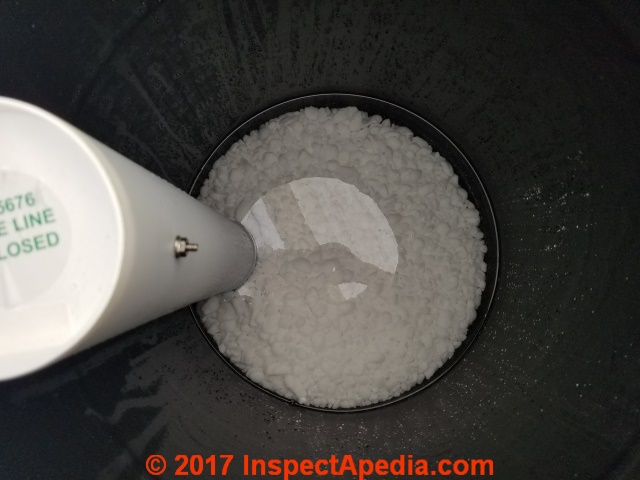 The brine tank refill cycle is brief, typically 5-6 minutes. In some water softener manuals, step 4, fast rinse and step 5, brine tank refill, are combined in describing a 6-10 minute cycle time.
The brine tank refill cycle is brief, typically 5-6 minutes. In some water softener manuals, step 4, fast rinse and step 5, brine tank refill, are combined in describing a 6-10 minute cycle time.
Our photo shows water back in the salt tank to make brine for the next water softener regeneration cycle.
This water level in the water softener is normal.
However if the water softener were filled to capacity with salt crystals or tablets, you probably won't see water at all until about half of the salt supply has been consumed and the salt level thus has fallen in the salt tank.
If you think the water level in your brine tank is abnormal see
See also WATER SOFTENER SALT DOSE SETTING as that determines how much salt is used at each regen cycle and thus how much water should be pumped into and then back out of the brine tank.
How often a water softener needs to backwash and recharge itself depends on two factors: how much water is used in the building and how hard the water is.
How much salt a water softener uses at its backwash cycle depends on the hardness of the water being processed.
How much water a water softener uses during its regen/backwash cycle depends on the water hardness, salt dose, and resin tank size as well as the number of steps in the cycle.
The typical water softener regeneration cycle water volume will be between 60-150 gallons (230 - 550L)
Reader Question: Should water actually leave the water softener during a backwash cycle?
Never used a water softener before, went to do a backwash and regenerate.
Should the water actually leave the softener and then refill because it sounds as though it wants to run but no water is leaving the tank and filling back up - Jhar1986 9/19/2012
Reply: yes.
Water is used first to flush the resin tank of the water softener, then after brine from the brine tank has re-charged the water softener, more water is used both to re-fill the brine tank and to finish flushing and preparing the resin tank.
Comparing Swap-in, Manual, Twin Tank & Automatic Water Softener or Water Conditioner Features
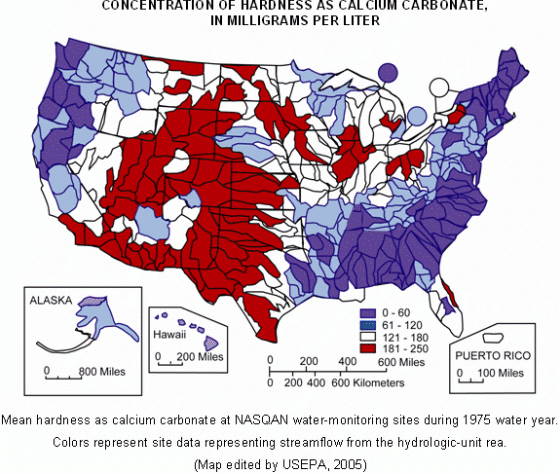
Water softeners address these two variables and is regenerated or "recharged" by these means
- Offsite or "swap-in" water softeners: a water softener treatment tank is brought into the home and installed using quick-disconnect plumbing fittings. On a regular schedule a water treatment company comes by and swaps out the old treatment tank, installing a new one that has been regenerated or cleaned at their facility.
This type of water softener does not use any electricity and has no controls other than a bypass valve. (We had one in our first home, maintained by Culligan™). - Manual water softeners: manual backwash/regeneration cycle of the water softener initiated by the owner who is supposed to notice that the water feels "hard" (can't get a lather in the shower) or as part of maintenance say when the water softener has been shut down for a week or more
- Automatic regular periodic backwash/regeneration in the water softener accomplished by a clock timer attached to the water softener
- Automatic "as needed" backwash/regeneration in the water softener, controlled by a sensor in the (more costly) water softener monitors either water hardness (water hardness sensor) at the softener outlet pipe or the total volume of water used (water metering) and backwashes (regenerates) when needed.
- Twin-tank water softeners are available for installations (such as commercial) where 24-hour availability of soft water is needed. - IBC.
What are the Controls on a Water Softener / Conditioner & What do They Do?
The water softener installer sets up the water softener control to specify
- How often the automatic periodic regeneration cycle should occur, such as once a week, once every other day, etc.
- What time of day the regeneration cycle should occur - typically at 2AM when people are unlikely to be using water
- How much water should be used during the water softener backwash - regeneration cycle - this is specified by adjusting the time-duration of the backwash cycle.
Factory default is typically 10 minutes of backwash time. The cycle may be adjustable to a time ranging between 5 minutes and 30 minutes as needed.
The number of gallons of water used during the water softener backwash cycle varies depending on the water pressure and flow rate in the building water supply piping.
A rough guess would be a typical volume of about 30 gallons of water (3 gpm for 10 minutes) but could be as little as 10 gallons or as much as perhaps 150 gallons (5 gpm for 30 minutes). If your water softener is running longer than 30 minutes during a backwash cycle it may not be working properly. - How much salt should be used during the water softener regeneration cycle
Some experts suspect that many homeowners use more salt and more frequent backwashing than the water usage and hardness require.
...
Continue reading at WATER SOFTENER ADJUSTMENT & CONTROLS or select a topic from the closely-related articles below, or see the complete ARTICLE INDEX.
Or see WATER SOFTENER OPERATION FAQs - questions & answers posted originally at this article.
Or see these
Recommended Articles
- DIAGNOSE WATER SOFTENER PROBLEMS
- INSTALLATION of WATER CONDITIONERS
- WATER CONDITIONER / SOFTENER MANUALS
- WATER SOFTENERS & CONDITIONERS - home
- WATER SOFTENER CONTROL ADJUSTMENT SETTINGS
- WATER SOFTENER CONTROLS & OPERATION
- WATER SOFTENER CONTROL BYPASS VALVE
- WATER SOFTENER SALT CHOICES
- WATER SOFTENER SALT DOSE SETTING
- WATER SOFTENER BRINE TANK DIAGNOSIS & REPAIR
Suggested citation for this web page
WATER SOFTENER OPERATING CYCLES at InspectApedia.com - online encyclopedia of building & environmental inspection, testing, diagnosis, repair, & problem prevention advice.
Or see this
INDEX to RELATED ARTICLES: ARTICLE INDEX to WATER TREATMENT SYSTEMS
Or use the SEARCH BOX found below to Ask a Question or Search InspectApedia
Ask a Question or Search InspectApedia
Try the search box just below, or if you prefer, post a question or comment in the Comments box below and we will respond promptly.
Search the InspectApedia website
Note: appearance of your Comment below may be delayed: if your comment contains an image, photograph, web link, or text that looks to the software as if it might be a web link, your posting will appear after it has been approved by a moderator. Apologies for the delay.
Only one image can be added per comment but you can post as many comments, and therefore images, as you like.
You will not receive a notification when a response to your question has been posted.
Please bookmark this page to make it easy for you to check back for our response.
IF above you see "Comment Form is loading comments..." then COMMENT BOX - countable.ca / bawkbox.com IS NOT WORKING.
In any case you are welcome to send an email directly to us at InspectApedia.com at editor@inspectApedia.com
We'll reply to you directly. Please help us help you by noting, in your email, the URL of the InspectApedia page where you wanted to comment.
Citations & References
In addition to any citations in the article above, a full list is available on request.
- [1] North Dakota Standards for Water Softeners, North Dakota General Authority Law, Chapter 62-04-08, Water Softener Units http://www.legis.nd.gov/information/acdata/pdf/62-04-08.pdf. "The objective of this chapter is to provide a standard of quality, capacity, and performance for water softener units. Water softener performance is to be based upon referee tests procedures described in section 62-04-08-09."
- [2] Culligan Mark 10 Water Softener 1994-1998 Installation and Operating Instructions (covering models manufactured after 1995) (1-96) 01881948.pdf available from www.culligan.com
- [4] "Commercial Water Softener Installation and Operating Instructions", IBC Filtration & Water Treatment Products (Australia) for commercial, industrial and residential application www.ibcwater.com.au (07) 3219 2233
- [5] "Non electric water softener, Installation and Operating Instructions", IBC Filtration & Water Treatment Products (Australia), op.cit.
- [6] Watts Industries of North Andover, Mass., provides its ZRO-4 under counter system intended to target the independent water dealer market.
- [7] "Water Softener Twin Tank Installation and Operating Instructions", IBC Filtration & Water Treatment Products (Australia), op.cit.
- [11] Thanks to reader Walter Schwartz for discussing water softener salt dose settings - September 2010
- In addition to citations & references found in this article, see the research citations given at the end of the related articles found at our suggested
CONTINUE READING or RECOMMENDED ARTICLES.
- Carson, Dunlop & Associates Ltd., 120 Carlton Street Suite 407, Toronto ON M5A 4K2. Tel: (416) 964-9415 1-800-268-7070 Email: info@carsondunlop.com. Alan Carson is a past president of ASHI, the American Society of Home Inspectors.
Thanks to Alan Carson and Bob Dunlop, for permission for InspectAPedia to use text excerpts from The HOME REFERENCE BOOK - the Encyclopedia of Homes and to use illustrations from The ILLUSTRATED HOME .
Carson Dunlop Associates provides extensive home inspection education and report writing material. In gratitude we provide links to tsome Carson Dunlop Associates products and services.



